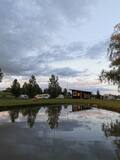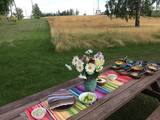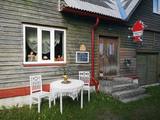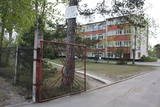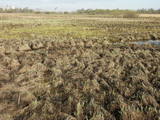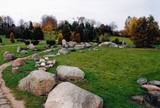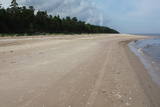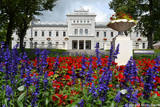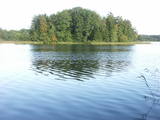| Nr | Name | Beschreibung |
|---|---|---|
|
Eines der bezauberndsten Strecken des Baltischen Küstenwanderweges im Nationalpark Matsalu. Sie führt durch landwirtschaftliche Nutzflächen und Küstenwiesen, auf denen sich im Herbst tausende von ziehenden Kranichen und Gänsen sammeln. Das Dorf Haeska (Küstenwiesen, wasserarme Buchten, kleine Inseln und Weiden) und die Umgebung des Puise-Kaps (Küstenwiesen mit Weiden und Sandbarren) sind ausgezeichnete Orte zur Vogelbeobachtung. Aus den Dörfern Põgari-Sassi und Puise nina heraus bietet sich malerischer Aussichten auf das Meer und die Inselketten. |
||
|
Lakeside Sigulda is a quiet camping and recreation area on the territory of Lake Matinu. Offers relaxation, overnight stays near nature and picnic options in a quiet environment. Travelers with campers, caravans, as well as those staying in tents can stay overnight in the camping area. In addition, a well-equipped glamping tent for 2 people has also been created. Showers, toilets, outdoor kitchen, picnic areas, grills, internet and electricity connection are available for camping guests. SUP boards are available for active recreation. |
||
|
Kauņas jūras reģionālais parks (Kauno marių regioninis parkas) dibināts 1992. gadā. Tas ietver Nemunas HES uzpludināto posmu – lielāko Lietuvas ūdenskrātuvi no Kauņas līdz Piļonas (Piliuona) ciemam. Viena no nozīmīgākajām parka vērtībām ir ainava, kas veidojusies ilgā cilvēka un dabas mijiedarbībā. Parkā konstatētas 950 augu sugas, 600 dzīvnieku, t.sk. - 34 zivju sugas. Parka nozīmīgas dabas vērtības ir meži, augstie purvi, kadiķu audze. Parkā ir apskatāmi dažādu vēsturisko periodu liecinieki – senču pilskalni, Pažaislis klosteris, Kauņas cietokšņa Piektais forts, kā arī Rumšišķes (Rumšiškės) brīvdabas muzejs – viens no lielākajiem (195 ha) šāda veida muzejiem Eiropā. Vaišvīdavā (Vaišvydava) ir izveidots parka apmeklētāju centrs, parkā ir dabas takas, piemēram, Žiegždriai ģeoloģiskā taka un Dubravos izziņas taka. |
||
|
The tour introduces a variety of attractions and values outside big cities revealing the true character of the countries. Visitors will experience the beauty of nature in national parks, charming ambience of rural manors, visit traditional rural farms and skilful traditional artisans and craftsmen. |
||
|
Ičas apmetnes ciems ir sena dzīvesvieta Ičas upes krastos. Apmetne atklāta 1937. gadā. Tā bijusi apdzīvota neolītā (4500 - 1500 pr.Kr.) un bronzas laikmetā (1500 - 500 pr.Kr.). Apmetnē dzīvojuši amatnieki, zvejnieki, mednieki.
|
||
|
The Samovar House is a small samovar museum located in the Old Believers’ village near Lake Peipus, which has a private collection with more than 100 different and very special samovars and objects related to samovars.
|
||
|
Zur Zeit befindet sich die Grundschule 3 im Platz, wo früher die Autoschule der Seestreitkräfte von Karaosta in Liepāja war.
|
||
|
Das Wohnhaus des Landgutes ist im 19. Jh. gebaut worden. Im Jahr 1932 hat das damals vernachlässigte Landgut der lettische Zeitungskönig Antons Benjamiņš gekauft. Heute befindet sich das Landgut wieder im Besitz der Familie Benjamiņš und dort ist eine private Fotoausstellung über die Reisen und das Leben von Antons Benjamiņš eingerichtet. |
||
|
The Narūta River which flows out of Lake Ežezers is approximately 1 km long and ends at the small Obiteļi windmill lake. On the right bank of the river is a windmill that was built around 1900. Today the site has the Obiteļa leisure centre with a sauna and banquet facilities. |
||
|
Between Saunags and Vaide on the road to Kolka, you will see an area on the left (South) side of the road where there was a massive forest fire in 1992 which burned approximately 3,300 hectares of forest. Biologists use the area to study the regeneration of the forest. There were extensive and destructive fires here during the early 20th century, as well. Swedish scientists say that there have been at least 15 fires in the forests of Šlītere over the last several centuries. The burned area is in a nature reserve and can only be viewed from the road. |
||
|
Natürliche Auenwiesen entlang der Ufer der Lielupe vor Jelgava. Viele geschützte Pflanzen findet man hier, Vögel nisten und rasten hier während des Vogelzugs.
|
||
|
The terrain in this territory was created during the Ice Age. There are the ancient river valleys of the Minija, Salantas and Erla rivers, along with groups of rocks.
|
||
|
In Ģipka wurde die erste Seefahrtschule in Kurland gegründet! Es geschah 1869 – einige Jahre nach der Gründung der Seefahrtschule in Ainaži. Diese Seefahrtschule war der 2. Kategorie, die die Steuermänner auf großer Fahrt und Kapitäne der Küstenschifffahrt vorbereitete. 1894 wurde die Schule nach Mazirbe verlegt. Vor der Eröffnung der Seefahrtschule befand sich seit 1860 in diesem Gebäude eine Schule, aber 1867 wurde für die Bedürfnisse der Seefahrtschule einen zweiten Stock gebaut. Das Gebäude ist bis heutzutage erhalten geblieben und ist in ein Wohnhaus umgebaut. Die Seefahrtschule (in Ģipka und Mazirbe) hat während ihrer 28-jahrigen Existenz mehr als 200 professionelle Seeleute vorbereitet und den Schiffbau in den livischen Küstensiedlungen gefördert. (Die Quelle: Roja TIZ) |
||
|
Leuchtturm von Tahkuna befindet sich an der Nordspitze von Hiiumaa. Der eiserne Turm wurde aus Frankreich gekauft und im Jahr 1875 in Tahkuna errichtet. Es ist der höchste Leuchtturm an der Küste von Estland – 42,7 m über Meeresspiegel. |
||
|
Diese großartige Wanderung beinhaltet einige der besten und schönsten Teile des Waldweges in Lettland und Estland. Wanderungen in den Waldwegen und Dörfern werden mit Ausflügen und Ausflügen in Städte sowie anderen beliebten Sehenswürdigkeiten in beiden Ländern kombiniert. Sie erhalten einen detaillierten Eindruck über die Waldvielfalt und die beliebtesten Nationalparks in Lettland und Estland. Sie beginnen die Tour in Riga, wo Sie die wunderschöne Altstadt der UNESCO und des Jugendstils genießen können. Dann fahren Sie nach Sigulda und sehen das malerischste alte Tal des Flusses Gauja, besuchen das Turaida Museum Reserve, wandern im Gauja National Park bis zum historischen Papiermühlendorf Ligatne. Weiter besuchen Sie die berühmte Burg des Āraiši-Sees, wandern auf den Cirulisi-Naturpfaden und sehen die wunderschöne mittelalterliche Stadt Cesis. Auf dem Weg nach Estland halten Sie an der großen Sandsteinklippe von Sietiņiezis, um einen malerischen Blick auf den Fluss Gauja zu haben. Dann bleiben Sie in Estlands zweitgrößter Stadt - Tartu - und besuchen das kürzlich eröffnete estnische Nationalmuseum. Weiter fahren Sie zum Alutaguse-Nationalpark und wandern entlang des malerischen Kurtna-Landschaftsreservats zwischen den hellen Nadelwäldern, die von den Spiegelflächen der vielen Seen geschmückt werden. Am Ende der Tour wandern Sie in Estlands ältestem Nationalpark - Lahemaa, was auf Estnisch „Land der Buchten“ bedeutet. Der Forest Trail führt entlang der Buchten und Halbinseln des Lahemaa-Nationalparks und führt die Wanderer in das bedeutendste Natur- und Kulturerbe ein. Die Wälder sind im Herbst reich an Blaubeeren und Pilzen und die Luft ist sehr sauber. Diese Tour endet mit einer Besichtigung von Tallinn, Estlands Hauptstadt. Die Altstadt gehört ebenfalls zur UNESCO. |
||
|
Das Wirtshaus befindet sich auf der bekanntesten Fußgängerstraße von Jurmala. Es ist ein für Jurmala charakteristisches Gebäude aus Holz mit einer angenehmen Innenausstattung, in dem lettische Speisen angeboten werden. Hier ist das breiteste Angebot an Fassbieren zugänglich, die in Lettland hergestellt werden. Lettische Küche: Strömlingschnitzel, Hechtfrikadellen, Lammfleischtopf nach dem Geschmack der Kurländer, geschmorte Schweinerippen, gebratene Ostseeflunder, Brotsuppe. |
||
|
In der gut geführten Gärtnerei, die über 3000 Arten, Formen und Sorten von Pflanzen hat, werden Führungen angeboten. Eine Besonderheit ist das breite Angebot an Wasserpflanzen. Neben dem Verkauf der Pflanzen gibt es Beratungen zur Standortwahl und Pflege. |
||
|
Plungė ist berühmt für der Park der Fürsten Oginski. Der Park im gemischten Stil wurde im 18.-19. Jh. anstelle eines vormals heiligen Bannwalds eingerichtet. Prunkstück des Parks sind eine der ältesten und mächtigsten Donnereichen (Perkunaseiche) in Litauen, die legendenumwobene Weinende Weide, die fünfstämmige Esche. Auf Geheiß des Fürsten Oginski wurden 7 Teiche in Kaskaden angelegt, verbunden mit steinernen Schleusen-Brücken. Ein besonderen Akzent für die Landschaft setzt das durchfließende Flüsschen Babrungas. |
||
|
Puderova Old-Believers Prayer House. The architectural monument of local importance was built in
the beginning of the 20th century.
|
||
|
Dieses Terrotorium schützt den See Jumurda, der sich im zentralen Teil des Vidzemer Hochlandes befindet, mit seinen drei Inseln, dem lokalen Laubwald und den umgebenden Landschaften.
|
||

